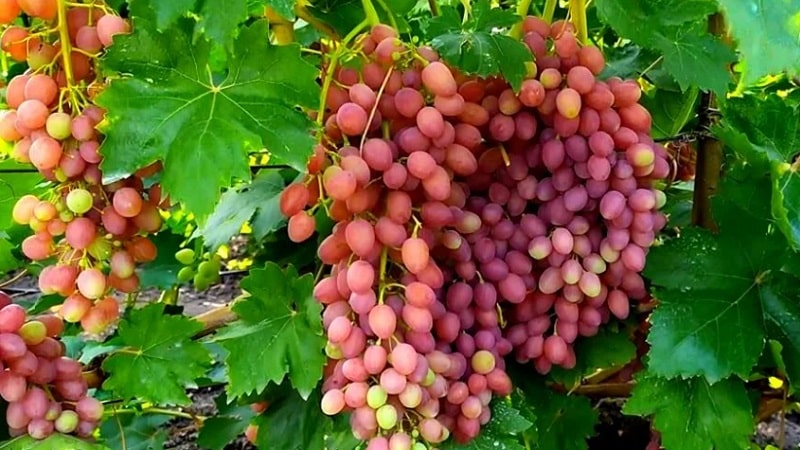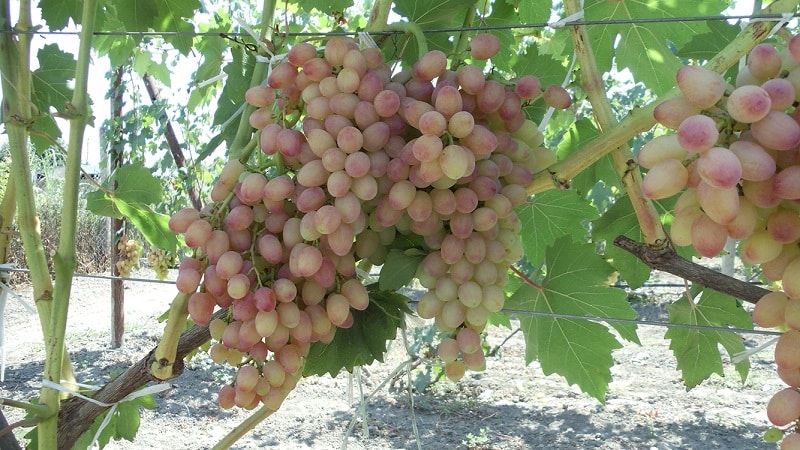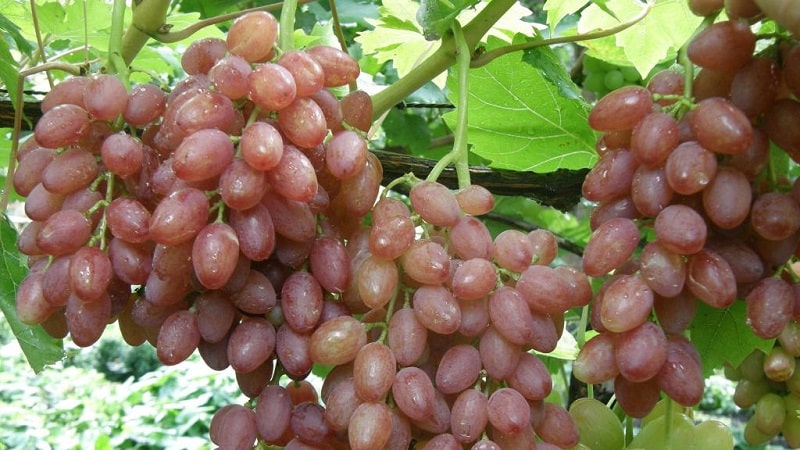Grape variety Kishmish Radiant
Kishmish is a type of seedless grape. Agronomists value it for its tasty fruits and ease of cultivation. The berries are suitable for fresh consumption, processing and drying. One of the popular varieties is the Moldovan Kishmish Radiant. This grape has taken root in Russia and is distinguished by its immunity and versatility in use. Let's take a detailed look at the description of the Kishmish Radiant grape and find out the features of its cultivation.
Description of the grape variety Kishmish Radiant
Seedless table grapes ripen in 130 days. The bushes are vigorous, the leaves are medium-sized, dissected, and formed on a long petiole. The surface of the leaves is shiny, there is no pubescence. The flowers are bisexual, so Kishmish Radiant consistently bears fruit in the absence of pollinating insects, even in rainy and windy weather. Grapes prefer space, so the distance between plants should be at least 2.5 m.

Characteristics
The clusters are winged and loose, weighing about 400 g. The berries are elongated-ovoid, pink-white in color. The skin is dense with a waxy coating, the flesh is fleshy and crispy, the taste is pleasant with a slight nutmeg aroma. The weight of one berry is 2-4 g. The tasting rating of Kishmish Radiant is 9.1 points out of 10. Adult plants produce up to 30 kg of harvest per season. Harvest time is early or mid-August.
Advantages and disadvantages
Advantages include resistance to gray rot and oidium. To protect against mildew, regular spraying with a solution of copper sulfate is required.Thanks to the thick peel, sultanas are transported over long distances; the fruits do not spoil or rot.
The advantages include the large size of the bunches, pleasant and juicy pulp. The fruits are universal in use - raisins, drinks, jams, preserves, marmalade and confiture are made from grapes.
Interesting! Kishmish is used not only in preparing sweet dishes and drinks. It is also used during the preparation of Uzbek pilaf. The berries give the dish a pleasant nutmeg taste and a sweetish aroma.
Cons of Kishmish Radiant — demands on mineral and organic fertilizing, mandatory shaping and pruning of shoots. If the rules of care are not followed, the grape yield decreases. Only spacious garden plots are suitable for planting seedlings, since the plant grows quickly and requires space, warmth and light.
Growing Kishmish Radiant
Not only the yield of a variety depends on compliance with the rules of planting and care, but also his immunity. Therefore, it is important to follow agrotechnical recommendations and deadlines.
Grow Kishmish Radiant is mainly found in warm regions, however with proper care, it shows high productivity in central Russia.

How to plant
It is recommended to plant Kishmish Radiant in spring — frost-resistant variety is no different, so it is important that the seedlings take root in the soil over the spring and summer. The soil should be neutral or slightly acidic; sultanas do not take root in soils with high acidity. Summer residents choose a planting site away from swampy and wet lands, otherwise there is a high risk of developing fungal and viral diseases.
The landing procedure looks like this:
- At the end of April, gardeners prepare the ground: they dig a hole 60-70 cm deep, make a drainage layer of small stones or broken bricks, and add liquid manure.
- A peg is placed in the center of the hole, a seedling is placed, covered with loose soil, and watered abundantly with warm water.
- After 2 days, mulch the seedling with mowed grass, leaves, hay and sawdust. Mulch retains moisture and improves the nutrition of the young plant.
Healthy seedlings are selected for planting: They must be flexible and resilient, without cracks, stains or other defects. 2-3 days before planting, they are soaked in a solution of superphosphate, soil and peat. The mixture is placed in a bucket and seedlings are placed in it. Soaking strengthens the plant’s immunity and helps in the future to quickly adapt to climatic conditions.

Care
Caring for grapes consists of watering and fertilizing, trimming and shaping. If these procedures are not followed, the grapes grow small and insipid, the bushes often get sick, and the roots are damaged by insect pests.
Shaping and trimming
Young grapes are formed with the arrival of spring. On the central shoot, 2 lower buds are selected, vines are grown from them, and they are tied to a trellis with an inclination in different directions.
Cut off in autumn regrown stems. Bush pruning depends on age. If the sleeve is new, trim by 2-3 eyes; if the sleeve is old, by 10-14 eyes. It is not recommended to leave more than 35 eyes of the total load. After the procedure, there should be 4 vines left, each 3-3.5 m long.
In the second year, shoots are tied to the bottom wire with their tips in different directions.. And with the arrival of autumn, the long sleeve is shortened again - only 2-3 shoots are left on it. If you do not prune them, the vines will become tangled, which will negatively affect the yield.
Fertilizer and watering
Kishmish Radiant requires moderate watering. Moisten the soil every 14 days, adding water to the roots. If the soil is sandy and dry, it is recommended to water the grapes more often. At the same time, it is important not to over-moisten the sultanas - due to an excess of water, the fruits become sour or bland.

Summer residents It is advised to water the plant in the morning or evening to avoid sunburn. Before watering, the row spacing is loosened and weeds are removed. With these procedures, water does not evaporate from the surface of the soil, but penetrates deep into the roots. Watering is stopped 14 days before harvest.
For fertilizer use root and foliar feeding. The former strengthen the plant’s immunity, the latter protect against diseases and pests. The frequency of the procedure is 2-3 times per season. It is not recommended to fertilize regularly, since an excess of mineral elements provokes diseases and slows down the ripening of berries:
- During the flowering period, magnesium sulfate or potassium monophosphate is added. Fertilizers stimulate the development of flowers and ovaries.
- After planting, add organic matter - manure, compost, bird droppings. They are used in dry form, but most often in the form of an infusion or solution.
- During the ripening period, they focus on mineral fertilizers - they add “Solution”, “Florovit”, “Garden mixture” to the soil. Before application, watering with warm water is required.
- During the entire ripening period, the grapes are sprayed with Novofert or Kimira. They protect grapes from powdery mildew, fruit rot, mildew and strengthen the plant’s immunity.

Shelter for the winter
The frost resistance of the variety is below average, so the grapes need annual shelter for the winter. In central Russia, the plant is covered at the end of October or beginning of November, before the onset of frost.
There are two shelter options - dry and wet. When covering dry, the vines are isolated from mulch using a thick film or agrofibre, and then covered with covering material. When wet, mulch is spread over the vines. Summer residents use earth or snow as covering materials - this is a quick and economical option.
Attention! Some summer residents use slate for shelter. Ditches 20 cm deep are dug along the grape bushes, the vines are wrapped in clean and dry burlap, covered with pieces of slate and sprinkled with earth. Slate has been used for many years; it reliably protects plantings from winds and frosts.
Reviews
What they say about the Radiant Kishmish grape variety in reviews.
 Nikolay, Moscow region: “I like Radiant Kishmish because every year I collect 10-12 bunches from the bush. The berries taste good, we eat them with the whole family and use them to make raisins. I grow a plant in the country, I water it once every 2 weeks, sometimes less often if it rains. After ripening, the sultanas hang on the branches for another week without falling off.”
Nikolay, Moscow region: “I like Radiant Kishmish because every year I collect 10-12 bunches from the bush. The berries taste good, we eat them with the whole family and use them to make raisins. I grow a plant in the country, I water it once every 2 weeks, sometimes less often if it rains. After ripening, the sultanas hang on the branches for another week without falling off.”
Polina, Krasnodar region: “I can only give a good description of Kishmish Radiant - I love soft berries without seeds. For the winter I cover it with film, every year I prune the vines for high yields. There are 3 bushes of this variety growing on the plot, I’m very pleased”.
Olga, Saratov: “Last year, the buds on my Kishmish Radiant bushes froze, and the harvest turned out to be meager. This year there were no such problems, but the berries grew a bit stale. Overall, I rate the variety a three.".
Conclusion
Kishmish Radiant is a mid-season seedless grape variety. It is grown in central Russia and the southern regions; spacious, sunny and dry garden plots are used for planting.To get a rich harvest, summer residents cover the bushes for the winter, and in the spring they form and prune the vines. They also regularly fertilize the soil to strengthen the immunity of the grapes and spray the bushes to protect them from diseases and pests.
Ripe clusters acquire a pinkish tint, the taste is pleasant, sweet, with a nutmeg aroma. Kishmish Radiant is suitable for fresh consumption, processing and storage.